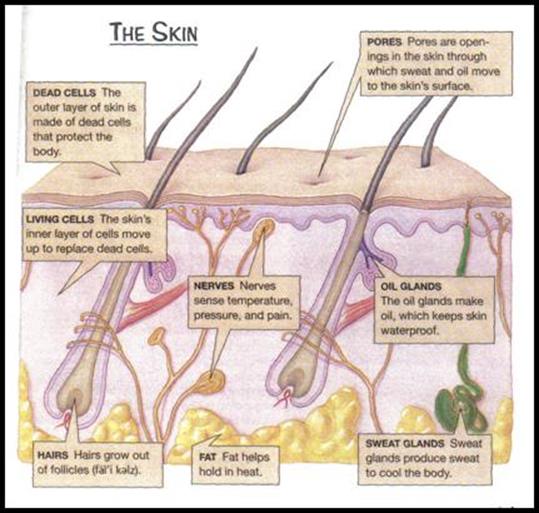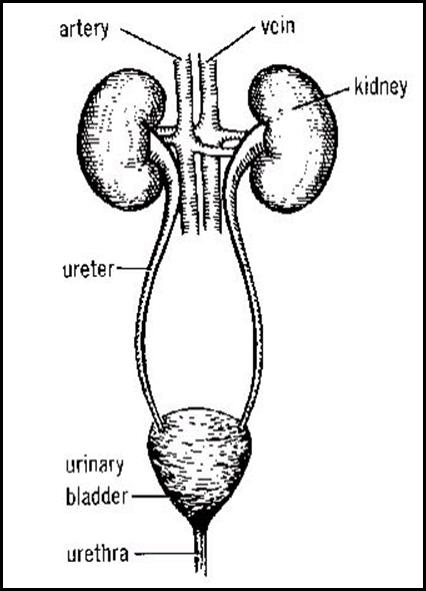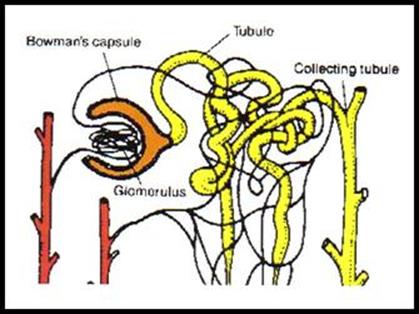![j0231724[1]](HEALTHU04The_Excretory_System_image003.png)
THE
EXCRETORY SYSTEM
Unit Overview
In
this unit you will be exploring the excretory system and learning how your body
gets rid of wastes. The four organs
responsible for excretion will be covered and you will learn how they operate. Good luck!
The Human Excretory System
What
we're dealing with here are the organs in the body that have a role in removing
metabolic wastes. Let's clarify what we mean by "metabolic wastes".
Metabolic wastes are by-products of metabolism. That's fine and dandy as long
as we know what metabolism means.
|
me-tab-o-lism \ma'tab-e-liz-em\ n |
the
sum total of the chemical reactions that keep an organism alive |
Examples
of these "chemical reactions" would be things like synthesis,
respiration, hydrolysis, and neutralization reactions. Each of them have a role
in keeping a living thing ticking; and in so doing, each produces certain waste
products. These waste products are referred to as metabolic wates.
Let
me put it this way: humans must get rid of two types of wastes. Wastes from the
digestive system (feces) and wastes from metabolic activities (sweat and
urine). Removing digestive wastes (bowel movement) is called egestion. Removing
metabolic wastes is called excretion.
Video
Information
The following
video describes the functions of the excretory
system, which is critical to survival. The many living cells in the human
body produce metabolic wastes, which must be eliminated from the body. These
wastes include carbon dioxide, urea, water, water vapor, and salts. The four
organs that make up the excretory system are the lungs, kidneys, liver, and
skin.
![]() An Introduction to the Excretory System
(02:14)
An Introduction to the Excretory System
(02:14)
Major Metabolic
Wastes
This
table summarizes the four types of metabolic wastes produced by humans
(and other animals) and the type of chemical reactions that produce them.
|
METABOLIC WASTE |
A BY-PRODUCT OF.... |
|
water |
dehydration
synthesis and respiration |
|
carbon dioxide |
cellular
respiration |
|
salts |
neutralization |
|
urea |
protein
metabolism, deamination |
- dehydration synthesis =
reactions in which small molecules are combined to form large molecules
- cellular respiration =
chemical reaction that releases energy from organic molecules (usually
glucose)
- neutralization =
reactions between acids and bases
- deamination =
removal of amino groups from protein molecules
Human Excretory
Organs
|
1. the Lungs |
|
2. the Liver |
|
3. the Skin |
|
4. the
Kidneys (Urinary System) |
Excretory Organ #1 = The Lungs
Cellular
respiration occurs in every living cell in your body. It is THE reaction that
provides energy (in the form of ATP molecules) for cellular activities. If
respiration stops, the cell no longer has energy for cellular activities and
the cell dies. As respiration occurs carbon dioxide is produced as a waste
product. As the carbon dioxide accumulates in body cells, it eventually
diffuses out of the cells and into the bloodstream, which eventually circulates
to the lungs. And here, in the alveoli of the lungs, carbon dioxide diffuses
from the blood, into the lung tissue, and then leaves the body every time we
exhale. We should note that some water vapor also exits the body during
exhalation.
Excretory Organ #2 = The Liver
The
liver is a large, important organ. In fact it is the largest internal organ in
our bodies. Its numerous functions make it "part" of the circulatory,
digestive, and excretory systems. You know what? The space below would make a
nice spot for a chart summarizing the jobs of the liver.
|
Excretory
Function |
As a result of
these reactions, a nitrogenous waste called urea is formed. |
|
Digestive
Function |
|
|
Circulatory
System |
It is also
responsible for maintaining "normal" levels of glucose in the
blood. When stimulated by insulin, the liver removes glucose form the blood
and converts it to glycogen for storage. When stimulated by the hormone
glucagon, the liver does the opposite: it breaks down glycogen, producing
glucose, which is released into the bloodstream. The liver is
also responsible for removing potentially hazardous chemicals from the blood.
It "detoxifies" the blood. For this reason, alcoholics and other
types of addicts have a higher incidence of liver disease. |
Excretory Organ #3 = The Skin
As
you already know, sweat comes out of pores in your skin. As you may not know,
sweat is a mixture of three metabolic wastes: water, salts, and urea. So as you
sweat, your body accomplishes two things:
1)
sweating has a cooling effect on the body
2)
metabolic wastes are excreted.
So,
how does the sweat form? Ah, good question. Let's look at a picture and picture
the sweat-making process.
I've
colored the sweat gland and the duct (tube) leadiing to the skin surface a nice
bright green so that they stand out.

What
you should notice about the skin is that there are two layers, the thin
epidermis at the top, and the thicker dermis below. The inner layer of skin
(dermis) is where we find oil glands, hair follicles, fatty layers, nerves, and
sweat glands.
Notice
that the sweat gland is a tubular structure tangled with capillaries (the
smallest of blood vessels). This close association of tubes allows wastes
(namely water, salts and urea) to diffuse from the blood and into the sweat
gland. And then, when body temperature rises, the fluid (sweat) is released
from the gland, travels through the tube (duct), and reaches the skin surface
through openings called pores.
Excretory Organs #4 = The Urinary
System
Ah,
the process of making urine is not as simple as you might think:
The
urinary system (pictured here) is composed of two kidneys, two tubes called
ureters, one urinary bladder, and another tube called the urethra.
You
probably know that the kidneys filter blood, so it's no surprise that there are
a couple of blood vessels attached directly to each kidney. The full names of
these vessels are the renal artery and the renal vein.
Three
of the four major metabolic wastes produced by the body are filtered from the
blood by the kidneys. Any idea which ones? They are water, salts, and urea (the
4th, carbon dioxide, is excreted by the lungs, remember?). These are the same
three wastes that sweat glands filter and excrete. So, yes, sweat and urine are
made basically from the same ingredients (except in different concentrations).
Each
kidney (which can be thought of as BIG filters) are made up of thousands of
tiny filtering sub-units called nephrons.
The
ureters are simply tubes that carry urine from the kidneys to the urinary
bladder.
The
bladder temporarily stores urine. And the urethra is the tube through which
urine leaves the body when you urinate.

Layers of
the Kidney
Ø
#1 - The
Cortex
This layer is jam-packed with lots and lots of those nephrons that I just
mentioned.
We'll get to the specifics on those in just a second.
Think of the cortex as the filtering layer of the kidney.
Ø
#2 - The
Medulla
The middle layer. Think of it as the collecting layer.
Tubes carrying filtered wastes travel from the cortex, through the medulla
towards the pelvis.
Ø
#3 -
The Pelvis
This is the area where all of the collecting tubules come together
and connect with the ureter (which is structure #4).
The ureter transports the wastes (urine) to the urinary bladder.
The Nephron - the
structural units of the Kidney
 The outermost layer of the kidneys, the
cortex, is composed of approximately 1,250,000 structural units called
nephrons. Blood is carried to the kidneys by the renal arteries, which branch
into smaller arteries inside the cortex and then lead to clusters of
capillaries called glomeruli. Each glomerulus is surrounded by a
"C"-shaped structure called the Bowman's Capsule. It is here that
materials such as urea, salts, water, glucose, and others pass from the blood
into the nephron. These materials (referred to as the "filtrate")
pass through the tubule, also known as the loop of Henle. As the filtrate
travels through the tubule, useful substances are reabsorbed into the
surrounding capillaries (which connect to veins that will transport the
"clean" blood back to the heart via the renal vein).
The outermost layer of the kidneys, the
cortex, is composed of approximately 1,250,000 structural units called
nephrons. Blood is carried to the kidneys by the renal arteries, which branch
into smaller arteries inside the cortex and then lead to clusters of
capillaries called glomeruli. Each glomerulus is surrounded by a
"C"-shaped structure called the Bowman's Capsule. It is here that
materials such as urea, salts, water, glucose, and others pass from the blood
into the nephron. These materials (referred to as the "filtrate")
pass through the tubule, also known as the loop of Henle. As the filtrate
travels through the tubule, useful substances are reabsorbed into the
surrounding capillaries (which connect to veins that will transport the
"clean" blood back to the heart via the renal vein).
About
180 liters of filtrate is produced each day, but only 1.5 liters of urine. So
as you can see, most materials that initially enter the nephron are reabsorbed,
leaving only the urea, salts, and some water in the tubule. These metabolic
wastes form urine, which is transported to the urinary bladder by the
collecting tubule.
There
you have it, the Human Excretory System.
![]() Summary of the Excretory System (00:51)
Summary of the Excretory System (00:51)
Very important in helping to maintain (my favorite word) ...............
homeostasis.
Homeostasis is the property of an open system, especially living organisms, to
regulate its internal environment to maintain a stable, constant condition, by
means of multiple dynamic equilibrium adjustments, controlled by interrelated
regulation mechanisms.
If we didn't excrete our metabolic wastes they would reach toxic levels and it
would be "curtains". So next time you sweat, urinate, or exhale, be
sure to say "thanks kidneys (or lungs or sweat glands) for saving my
life". Just make sure nobody hears you.
![j0371082[1]](HEALTHU04The_Excretory_System_image013.png) Now answer
questions 1 through 12.
Now answer
questions 1 through 12.

Below are additional educational resources and activities for this unit.